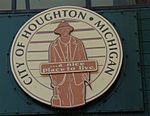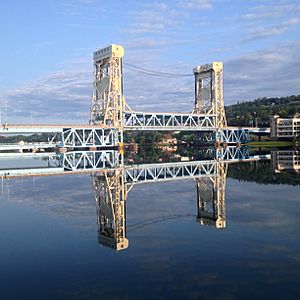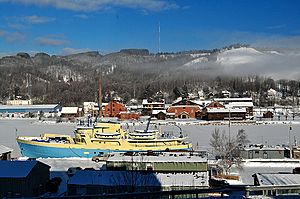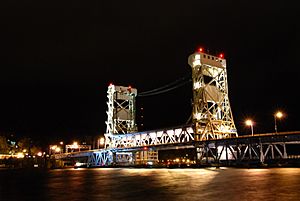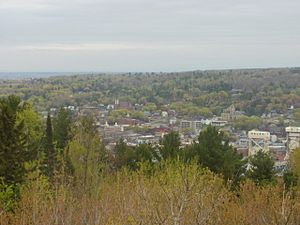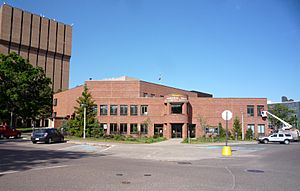Houghton, Michigan facts for kids
Quick facts for kids
Houghton, Michigan
|
||
|---|---|---|
| City of Houghton | ||
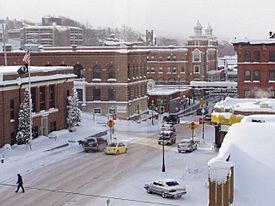
Downtown Houghton along U.S. Highway 41
|
||
|
||
| Nickname(s):
Hoton
|
||
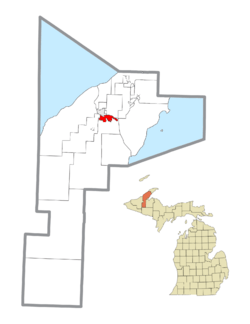
Location within Houghton County
|
||
| Country | United States | |
| State | Michigan | |
| County | Houghton | |
| Platted | 1854 | |
| Incorporated | 1861 (village) 1970 (city) |
|
| Government | ||
| • Type | City commission | |
| Area | ||
| • Total | 4.64 sq mi (12.01 km2) | |
| • Land | 4.39 sq mi (11.38 km2) | |
| • Water | 0.24 sq mi (0.63 km2) 5.12% | |
| Elevation | 643 ft (196 m) | |
| Population
(2020)
|
||
| • Total | 8,386 | |
| • Density | 1,910.25/sq mi (736.91/km2) | |
| Time zone | UTC-5 (Eastern (EST)) | |
| • Summer (DST) | UTC-4 (EDT) | |
| ZIP code(s) |
49931
|
|
| Area code(s) | 906 | |
| FIPS code | 26-39360 | |
| GNIS feature ID | 0628661 | |
Houghton ( HOE-tin) is the largest city and county seat of Houghton County in the U.S. state of Michigan. Located on the Keweenaw Peninsula, Houghton is the largest city in the Copper Country region. It is the fifth largest city in the Upper Peninsula, with a population of 8,386 at the 2020 census. Houghton is the principal city of the Houghton micropolitan area, which includes all of Houghton and Keweenaw County.
The city of Houghton and the county were named after Douglass Houghton, an American geologist and physician, primarily known for his exploration of the Keweenaw Peninsula. Houghton has been listed as one of the "100 Best Small Towns in America" despite it being considered a city. Houghton is home to Michigan Technological University, a public research college founded in 1885. Michigan Tech hosts a yearly Winter Carnival in February, drawing thousands of visitors from around the world.
Contents
History

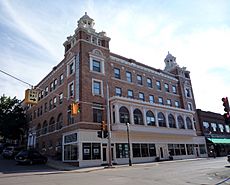
Native Americans mined copper in and around what would later be Houghton thousands of years before European settlement. "French explorers had noted... [its] existence [in the area] as early as the seventeenth century, [and in] 1772 Alexander Henry had prospected for copper on the Ontonagon River near Victoria." When Horace Greeley said, "Go West, young man" he was referring to the copper rush in "Michigan's western Upper Peninsula."
Many Cornish and Finnish immigrants arrived in the Houghton area to work in the copper mines; both groups have had a great influence on the culture and cuisine of the local area. The Finns and others called much of the area Copper Island. Smaller numbers of French-Canadian immigrants moved to Houghton, while more of them settled elsewhere in Houghton County.
The last nearby mines closed in the late 1960s, but a school founded in 1885 by the Michigan State Legislature to teach metallurgy and mining engineering, the Michigan College of Mines, continues today under the name of Michigan Technological University and is the primary employer in the city.
The first known European settler of Houghton was named Ransom Shelden, who set up a store named Ransom's near Portage Lake, though it is unclear whether this was in the same building as the 1852 Shelden and Shafer drugs, sometimes described as "the first commercial building constructed in Houghton," which Shelden owned with his son Ransom B. The main street of Houghton, variously called "Sheldon Avenue," (incorrectly) Sheldon Street, and Shelden Avenue, is named for him. In the 1970s the construction of a parking deck and the connection of downtown stores to create Shelden Center significantly changed the downtown.
William W. Henderson was appointed the first postmaster of Houghton in 1852.
Houghton gained in importance as a port with the opening of the Keweenaw Waterway in 1873, the waterway being the cumulative dredging and extension of the Portage Lake, Portage Shipping Canal and Lily Pond so as to isolate the northern part of the Keweenaw Peninsula into Copper Island.
In 1854, Ernest F. Pletschke platted Houghton, which was incorporated as a village by Shelden, C[hristopher] C[olumbus] Douglass and Capt. Richard Edwards three years later. In Houghton's first days it was said that "only thieves, crooks, murderers and Indians" lived there. The postwar boom and increasing demand for copper wiring fueled the development of Houghton in the 1860s and 1870s.
By 1880 Houghton had become "a burgeoning city" and in 1883, the railroad was extended from Marquette.
1909 saw the founding of what would later become Portage Lake District Library.
During the bitter Copper Country Strike of 1913-1914, the Michigan National Guard was called in after the sheriff petitioned the governor.
Houghton was the birthplace of professional ice hockey in the United States when the Portage Lakers were formed in 1903. Houghton is the home of the Portage Lake Pioneers Senior Hockey Team. The team's home ice is Dee Stadium, named after James R. Dee. Dee Stadium was originally called the Amphidrome, before it was severely damaged in a 1927 fire. (The stadium also contains a skatepark for skateboarding.)
In the winter of 2001, Houghton was the site of one of the first lumitalos (Finnish temporary snow houses) to be constructed in the United States.
Philatelic history
On October 28, 2002, the first day of issue ceremony was held in Houghton for the "snowman stamps" issued by the United States Postal Service.
One of the 2006 United States Postal Service snowflake stamps ("photographed in Houghton by Caltech physicist Kenneth Libbrecht using a digital camera and special microscope") was unveiled in Houghton.
A pictorial postmark commemorating Winter Carnival 2007, "Ancient Worlds Come to Play in Snowy Drifts of Modern Day," was applied at the Winter Carnival temporary station in Michigan Technological University's Memorial Union Building, February 10, 2007 (see below).
Geography
The city is located on the south shore of Portage Lake, primarily "on rolling wooded hills" "less than a mile" across Portage Lake." from Hancock. The city is bounded on the east by Portage Township and Pilgrim, on the west by Dakota Heights and on the south by Hurontown and Isle Royale Location, unincorporated communities that are part of Portage Township; and also on the west by Adams Township. Houghton is named after Douglass Houghton, discoverer of copper nearby. Houghton is also the home of Michigan Technological University. The city is served by Houghton County Memorial Airport.
According to the United States Census Bureau, the city has a total area of 4.69 square miles (12.15 km2), of which 4.45 square miles (11.53 km2) is land and 0.24 square miles (0.62 km2) is water.
In the West Houghton neighborhood is West Houghton Park, containing an outdoor ice rink and lawn tennis courts. Along Portage Lake is the Raymond Kestner Waterfront Recreation Area, the principal feature of which is a large "Chutes and Ladders" playground; it also includes Houghton Beach. Along the waterfront, in the area that used to be occupied by the railroad tracks, runs the "flat, paved" Waterfront Trail for bikers and pedestrians; at one end of this is the Houghton RV Park, at the other end the Nara Nature Park and midway along this corridor is "Mattila Square". Prince's Point is also along this trail. Veterans Park is just across the Portage Lake Lift Bridge from Hancock, and contains the memorial to the Houghton Company, which fought in the Civil War. Houghton is the headquarters for Isle Royale National Park.
The Portage Lift Bridge connects Hancock and Houghton, Michigan, by crossing over Portage Lake, which is part of the river and canal system that crosses the entire peninsula. The Portage Lift Bridge is the world's heaviest and widest double-decked vertical lift bridge. Its center span "lifts" to provide 100 feet (30 m) of clearance for ships. Since rail traffic was discontinued in the Keweenaw, the lower deck is used to accommodate snowmobile traffic in the winter. This is the only land based link between the north and south section of the Keweenaw peninsula, and is crucial.
Climate
Houghton has a humid continental climate but the (typically) long and snowy (due to lake-effect snow, with an average of 218 inches or 5.54 metres) winters make the city feel as though it is in a climate much further north. It holds the distinction of having the third-most (behind Duluth and International Falls in Minnesota) maxima below 32 °F or 0 °C of any incorporated city in the contiguous US, with the top temperature failing to reach freezing on 100.9 days per year. It is sometimes said that Houghton has “two seasons: winter’s here and winter’s coming.”
While Houghton’s winters may be the subject of humor, residents take the subject of snow and winter very seriously. Houghton is one of the premier “Winter Cities” found anywhere. A “Winter City” is a community that accommodates winter, celebrates it, and whose residents generally enjoy the season by participating in a variety of outdoor activities. Among those activities are cross country skiing, snow-shoeing, ice fishing, snowmobiling, ice skating and outdoor ice hockey, among other activities. Houghton celebrates winter through the “Winter Carnival” organized by Michigan Tech every year in February.
Houghton's summer climate tends to be especially pleasant, as hot temperatures are often moderated by the cool waters of the nearby Lake Superior. Only once, in July 1988, have temperatures hotter than 100 °F or 37.8 °C been reported. Temperatures below 0 °F or −17.8 °C are also relatively infrequent due to the moderating effect of the lake, being reached only on 18.3 nights per year as against over fifty at International Falls. The coldest temperature on record has been −26 °F (−32.2 °C) on 21 January 1984 – less extreme than most places to the west – and the heaviest monthly snow 119 inches (3.02 m) in December 1972. The highest mean snow cover has been 43 inches (1.09 m) on several occasions, most recently in February 1996.
| Climate data for Houghton, Michigan, 1971-2000 normals, extremes 1887-present | |||||||||||||
|---|---|---|---|---|---|---|---|---|---|---|---|---|---|
| Month | Jan | Feb | Mar | Apr | May | Jun | Jul | Aug | Sep | Oct | Nov | Dec | Year |
| Record high °F (°C) | 50 (10) |
60 (16) |
79 (26) |
88 (31) |
95 (35) |
99 (37) |
102 (39) |
97 (36) |
92 (33) |
86 (30) |
71 (22) |
64 (18) |
102 (39) |
| Average high °F (°C) | 21.6 (−5.8) |
24.8 (−4.0) |
33.7 (0.9) |
47.1 (8.4) |
62.3 (16.8) |
70.8 (21.6) |
75.9 (24.4) |
73.6 (23.1) |
63.3 (17.4) |
51.6 (10.9) |
36.8 (2.7) |
26.0 (−3.3) |
49.0 (9.4) |
| Average low °F (°C) | 7.6 (−13.6) |
9.1 (−12.7) |
17.6 (−8.0) |
29.5 (−1.4) |
40.8 (4.9) |
49.3 (9.6) |
55.2 (12.9) |
54.7 (12.6) |
46.2 (7.9) |
36.4 (2.4) |
25.1 (−3.8) |
13.8 (−10.1) |
32.1 (0.1) |
| Record low °F (°C) | −29 (−34) |
−30 (−34) |
−23 (−31) |
−4 (−20) |
19 (−7) |
28 (−2) |
32 (0) |
34 (1) |
24 (−4) |
12 (−11) |
−7 (−22) |
−19 (−28) |
−30 (−34) |
| Average precipitation inches (mm) | 4.26 (108) |
2.28 (58) |
2.45 (62) |
1.71 (43) |
2.49 (63) |
2.84 (72) |
2.97 (75) |
2.75 (70) |
3.24 (82) |
2.56 (65) |
2.84 (72) |
3.42 (87) |
33.81 (857) |
| Average snowfall inches (cm) | 68.4 (174) |
33.4 (85) |
24.0 (61) |
7.1 (18) |
1.1 (2.8) |
0 (0) |
0 (0) |
0 (0) |
0.1 (0.25) |
4.0 (10) |
23.8 (60) |
56.1 (142) |
218 (553.05) |
| Average precipitation days (≥ 0.01 inch) | 22.7 | 15.8 | 12.6 | 9.6 | 10.3 | 10.8 | 10.0 | 9.9 | 12.7 | 13.1 | 15.4 | 19.7 | 162.6 |
| Average snowy days (≥ 0.1 inch) | 23.6 | 15.6 | 10.3 | 4.8 | 0.9 | 0 | 0 | 0 | 0.1 | 2.5 | 12.0 | 19.7 | 89.5 |
| Source 1: National Oceanic and Atmospheric Administration | |||||||||||||
| Source 2: National Oceanic and Atmospheric Administration | |||||||||||||
People and culture
Every summer, the city of Houghton hosts a festival known as "Bridgefest", to commemorate the building of the Portage Lake Lift Bridge; this is often held in conjunction with "Seafoodfest". Every fall, the Parade of Nations takes place in downtown Houghton to commemorate the ethnic diversity of Michigan Technological University. "Strawberry Fest" is held every summer, which not only celebrates the fruit, but also includes an art market with paintings, photos, sculptures, and crafts.
The city houses two museums. The Carnegie Museum, located in the former Portage Lake District Library building, contains photographs from the Raffaelli Historical Photo Collection, other artifacts on the history of the local area, a mural depicting the history of Houghton, Ontonagon, Baraga and Keweenaw Counties and exhibits of artwork. The AE Seaman Mineral Museum, state mineral museum of Michigan, is located on the campus of Michigan Technological University.
Houghton is often the host of winter sporting events, due to its long winters and many ski hills. The 2006 Cross Country Skiing Junior Olympics took place in Houghton. The US National Championships for Nordic Skiing took place in Houghton in January 2007. In addition, the International Frisbee Tournament (IFT) takes place every year in Houghton and the roll-out of the distance events of the Keweenaw Chain Drive bike races of Houghton and Hancock takes place in downtown Houghton.
Other winter events focus around Michigan Technological University. Michigan Tech hosts a yearly Winter Carnival in which thousands of visitors come to see snow sculptures built by members of fraternities, sororities, other student organizations, as well as a few community groups, and participate in the week-long celebration. Students at the university also receive several days of vacation for Carnival. As part of Winter Carnival 2006, the city of Houghton and the university broke three world records: the largest snowball, the largest snowball fight, and the largest number of people making snow angels in one place. They currently still hold two of these records: largest snowball and largest snowball fight.
The Daily Mining Gazette (formerly The Mining Gazette) is a daily newspaper published in Houghton.
The town is sometimes referred to by locals as "Hoton" or "Ho-town." "Hoton" is even stenciled on city property. Since Houghton and Hancock are very near each other, their combined area is often referred to as "Houghton-Hancock," though the towns are often fierce rivals, something particularly manifested by the sports rivalry between Houghton High School and Hancock Central.
Tourism is a major industry in Houghton. Summer tourism is very popular, especially among those wishing to tour old mines, visit various historical sites, and camp. Winter tourism is also very active from November through April, for snowmobiling, skiing and other winter sports.
Demographics
| Historical population | |||
|---|---|---|---|
| Census | Pop. | %± | |
| 1860 | 2,157 | — | |
| 1880 | 1,438 | — | |
| 1890 | 2,062 | 43.4% | |
| 1900 | 3,359 | 62.9% | |
| 1910 | 5,113 | 52.2% | |
| 1920 | 4,406 | −13.8% | |
| 1930 | 3,757 | −14.7% | |
| 1940 | 3,693 | −1.7% | |
| 1950 | 3,829 | 3.7% | |
| 1960 | 3,393 | −11.4% | |
| 1970 | 6,067 | 78.8% | |
| 1980 | 7,512 | 23.8% | |
| 1990 | 7,498 | −0.2% | |
| 2000 | 7,010 | −6.5% | |
| 2010 | 7,708 | 10.0% | |
| 2020 | 8,386 | 8.8% | |
| U.S. Decennial Census | |||
2020 census
As of the census of 2020, there were 8,386 people residing in the city, living in 2,533 households with an average of 2.30 people per household.
2010 census
As of the census of 2010, there were 7,708 people, 2,380 households, and 907 families residing in the city. The population density was 1,732.1 inhabitants per square mile (668.8/km2). There were 2,516 housing units at an average density of 565.4 per square mile (218.3/km2). The racial makeup of the city was 85.2% White, 1.0% African American, 0.4% Native American, 11.2% Asian, 0.1% Pacific Islander, 0.4% from other races, and 1.8% from two or more races. Hispanic or Latino of any race were 1.8% of the population.
There were 2,380 households, of which 18.4% had children under the age of 18 living with them, 28.6% were married couples living together, 6.3% had a female householder with no husband present, 3.2% had a male householder with no wife present, and 61.9% were non-families. 32.1% of all households were made up of individuals, and 11.9% had someone living alone who was 65 years of age or older. The average household size was 2.37 and the average family size was 2.82.
The median age in the city was 22.1 years. 10.1% of residents were under the age of 18; 56.2% were between the ages of 18 and 24; 16.1% were from 25 to 44; 10.5% were from 45 to 64; and 7% were 65 years of age or older. The gender makeup of the city was 64.3% male and 35.7% female.
Transportation
Highways
 US 41 courses north to Hancock and Copper Harbor. To the south and east US 41 routes to L'Anse and Marquette.
US 41 courses north to Hancock and Copper Harbor. To the south and east US 41 routes to L'Anse and Marquette. M-26 connects Houghton southwest to US 45.
M-26 connects Houghton southwest to US 45.- M-203 provides a loop route from US 41 in neighboring Hancock to McLain State Park. and then back to US 41.
Bus
Indian Trails bus lines operates daily intercity bus service between Hancock, Michigan and Milwaukee, Wisconsin.
Houghton Motor Transit operates both a demand bus and a route bus throughout Houghton and in nearby parts of Portage Township; there are also night trips to Mont Ripley in Ripley.
Ferry
Houghton is the port of departure for Isle Royale National Park. Cruise ships on the great lakes formerly (in the 1950s) used to frequently stop in Houghton, but this is now an exceedingly rare occurrence.
Airport
Houghton is served by the Houghton County Memorial Airport, which has limited commercial service.
Houghton was formerly served by airship. A seaplane departs from Houghton to Isle Royale National Park.
Snowmobiling
Snowmobiling is a major winter activity in the area, both locally (snowmobiles are often the best available means of transportation after a blizzard) and as a tourist industry. The Bill Nichols Snowmobile Trail has a terminus in Houghton.
Neighborhoods
Houghton is generally said to be divided into East Houghton, the Central Houghton area (which includes the downtown) and West Houghton.
- East Houghton runs from Franklin Square to the eastern city limits. A principal street is College Avenue, characterized by Colonial Revival homes, which formerly ran from urbanized Houghton "farms, villas and mining operations... and the Michigan School of Mines, now Michigan Technological University;" today the main campus of MTU has taken over much of the College Avenue area and some of East Houghton generally, though it remains a primarily residential neighborhood. (However, this has changed somewhat with construction of the Pearl Street Mall. The Chassell Sands, which are usually considered apart from it, are partially zoned "Industrial.") It is home to East Houghton Park. The park was established in 1974 and contains tennis courts and playground equipment. The Chassell sands may be technically said to be part of this neighborhood, but are usually considered as apart from it, as is Minoru Yamasaki-designed Daniell Heights, married-student housing at Tech.
- Central Houghton is a relatively urbanized area of the town, generally considered as being roughly between Franklin Square and the Portage Lake Lift Bridge. The "heart of Houghton's commercial district" is characterized by sandstone (frequently mined from Jacobsville or Portage Entry) buildings with the frequent "classical detail"; it is centered on Shelden Avenue, the downtown lying in Central Houghton between Montezuma Avenue and Lake Street / Brew Alley / Lakeshore Drive, which are generally considered one continuous street. South of this area are a series of streets with small wooden houses, primarily from mining days, rising over the arc of the hills that the city is built upon. Northward is the waterfront, which has several dockyards, and older buildings alongside it. While Corktown is the area around St. Ignatius Catholic Church, this neighborhood is rarely spoken of today.
- West Houghton is the site of more recent construction compared to the other two neighborhoods. Therefore, the area has a more modern, suburban feel to it than the other areas. This includes larger middle class houses built with large wooded lots between them. Most prominent in this area, however, are the retail stores which are becoming the new commercial heart of the city. These include Walmart, ShopKo, and several recent strip malls, with numerous small stores housed under a single roof. Several prominent beach areas are located on this side of the city. It is often referred to by locals as "ShopKo Heights," the "neighborhood behind ShopKo," or "ShopKoville."
Micropolitan area
The Houghton, Michigan micropolitan area is a statistical aggregation of the United States census bureau.
In popular culture
Houghton figures in the novels A Superior Death and Winter Study by Nevada Barr and the Robin Hamilton mystery series by Nancy Barr. Much of Ander Monson's Other Electricities takes place in Houghton. Comedian John Oliver also talks about Houghton in a February 2010 comedy show performed at Michigan Tech.
- Maki, Wilbert, "Hockey finals here?" (letter to the editor), The Daily Mining Gazette, January 27, 2001.
- Gray, Dick, "Our Story" (website), Keweenaw Brewing Company, November 5, 2007
Education
The local school district is Houghton-Portage Township Schools. Students K-12 are served by Houghton Elementary (K-5), Middle (6-8), and High (9-12) Schools. Houghton is also the home of Michigan Technological University.
Notable people
- Norm Breyfogle, American comic book artist
- George Brunet, Major League Baseball pitcher for nine teams
- Avis DeVoto, American culinary editor, book reviewer, and cook
- Dolly Gray, baseball player, MLB and Pacific Coast League Hall of Fame
- Chuck Klingbeil, former National Football League player for the Miami Dolphins
- Nancy Harkness Love, World War II pilot
- P.J. Olsson, rock singer
- Eugene Parker, solar astrophysicist
- Percy Loomis Sperr, historical photographer
Images for kids
See also
 In Spanish: Houghton (Míchigan) para niños
In Spanish: Houghton (Míchigan) para niños


